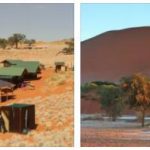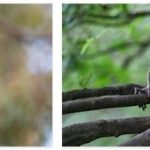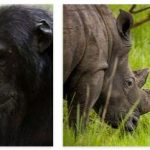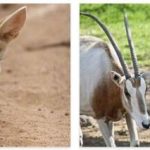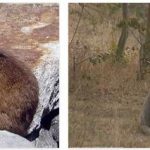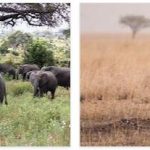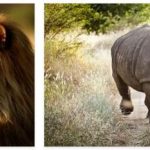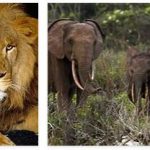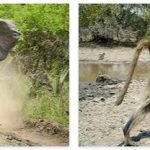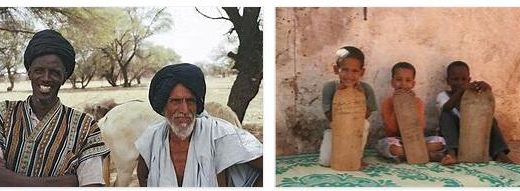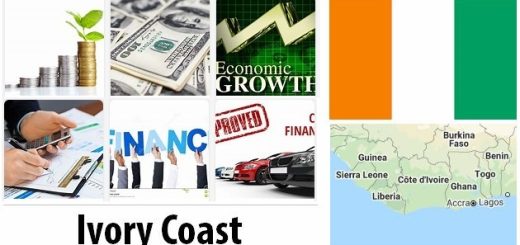Namibia Wildlife and Economy
Animals and Plants
National parks protect Namibia’s nature
Many animals in Namibia live in national parks. Despite the many deserts and hostile landscapes, there is a great diversity of species to discover in Namibia. The largest park in the country is the Etosha National Park.
What is growing there in Namibia?
For Namibia grass and steppe landscapes are typical, as you can see them in the photo above. Since the climate is very dry, only plants that are optimally adapted to the climate can survive. There is hardly any forest in Namibia. Trees grow mainly along the rivers. The camel thorn tree, which you can see in many photos from Namibia, is typical for Namibia.
The national plant of Namibia is called Welwitschia. It only grows in the Namib desert. These plants can get very old.
The quiver trees are just as photogenic. Their branches are twofold. The crowns are dense and form a hemisphere. There is even a whole quiver tree forest in Namibia. The tree actually grows sporadically, which is why this forest is so unusual.
Animal protection in Namibia
300 mammal species, 500 bird species and 100 reptile species have a home in Namibia. 17 percent of the total land area is under nature protection. In addition to the protected areas that are maintained and administered by the state, there are also many private animal protection areas in Namibia.
The animal population in Namibia has been able to preserve well, as many wild animals are protected. Nevertheless, poachers often hunt rhinos. Their horn is very valuable and is often sold, which is why they are unfortunately always hunted.
Which animals live in Namibia?
In the Etosha National Park in particular, many animals still live in large herds. These include lions, elephants, zebras, giraffes and springboks. Warthogs, spotted hyenas, antelopes, African buffalos, hippos and cheetahs are also at home here.
Among the reptiles, desert monitors and crocodiles can be found, but also the funny geckos. There are also a number of poisonous snakes such as the African tree snake, the black mamba, the desert viper and many different species of adder. In addition to poisonous snakes, there are also harmless snakes in Namibia, such as the South African python.
Flamingos, vultures, guinea fowl, cranes, herons and the African ostrich are bird species that also find good living conditions in Namibia.
In addition, there are many species of insects, of which only the praying mantis, which its male eats, should be mentioned, as well as the termites, which are very small themselves, but build huge termite mounds.
Economy
Mining and agriculture
Mining plays a particularly important role in Namibia’s economy. Above all diamonds and uranium are mined. But gold, copper, lead and zinc as well as precious stones are also mined. Namibia exports these products abroad and they make up at least half of its exports. For more articles on Namibia and Africa, please visit ezinereligion.
But 50 out of 100 people in Namibia work in agriculture, even if this only makes a small contribution to the gross national product. Here is livestock, the main source of income. There are more than 4,000 farms in the country, on which cattle or sheep are primarily raised. The fishing has mainly includes on the coast importance so that fish, meat and grapes to the main export goods of the country.
Tourism brings a lot of income into the country
Tourism is also of great importance for the Namibian economy. There are many animal protection areas and nature parks in Namibia. Safaris are organized and many tourists stay in lodges – these are hotels – in the parks.
Stable economy
Overall, one can say that the Namibian economy is relatively stable for an African country. Intensive development aid also makes an important contribution. But the unemployment rate is high, 28 out of 100 Namibians have no job. Unemployment is particularly high among young people. Nevertheless, in comparison to the “richer” African countries, Namibia ranks.
The country’s road network is well developed and there is a fairly good rail network. There are also important trading ports on the Atlantic coast. However, Namibia also has to import many products, especially fuels and oil as well as electricity. Most of the products – as well as cars and machines – come from South Africa. In general, the Namibian economy is very closely intertwined with the economy of South Africa. This is also due to the history of the country.


